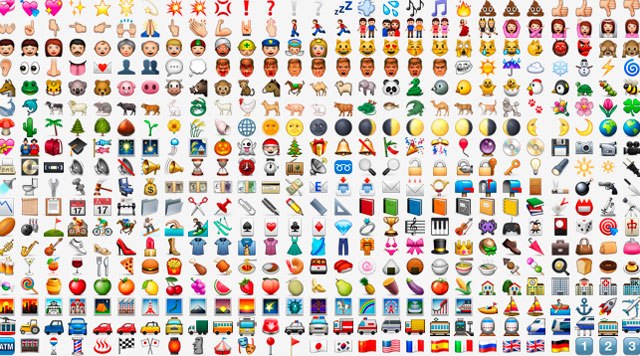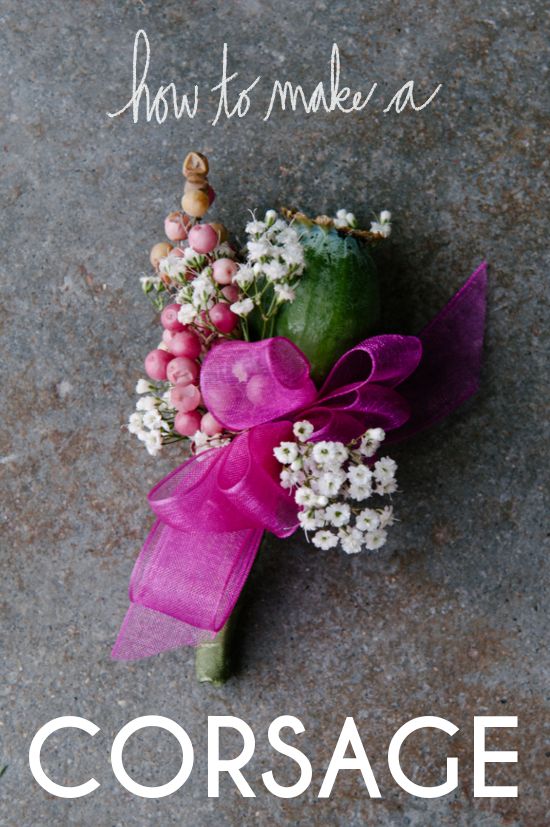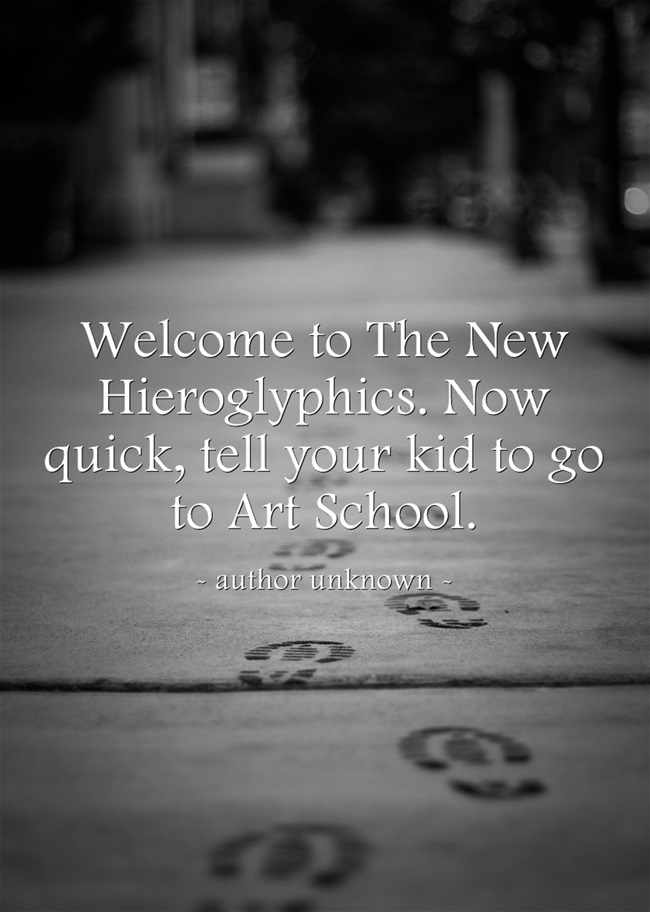Are we entering the New Age Of Hieroglyphics? What do I mean, you might well ask. Well, do you think our “written” language is in the process of becoming a hybrid communication system, in which words and images converge?
More specifically, do you know about “emojis?”
It’s an app that lets you add teeny pictures to everything you write on your phone. I’ve seen people comment in various places using only emojis. By the way, the Vanity Fair article where I found that graphic is really funny.
Emojis are the extreme form of the New Hieroglyphic. But elsewhere in the electronic universe, we see other stirrings. Twitter, King of 140-Letter and Number Sayings, has begun to show images inline, vs. via links only, and offer rich detail via Twitter Cards.
Facebook is perhaps the Empress of Postcarded Sayings. You can even make these Quote Postcards online, if you don’t want to bother with Photoshop et alia. Hold that thought.
On Pinterest, Queen of Pretty Pictures, you’ll see pins that overlay text, rather than relying on unincorporated text boxes. This is by A Practical Wedding.
Apparently the same is true of Instagram, but I confess to following only a few people.
We may not care about social media, or the Internet, very much. That is our right. But I still wonder about symbolic systems. If words come to require an associated image, and certain images even replace words, what does that mean for our shared understanding of the world, for the value of nuanced verbal analysis? I may have a dog in this hunt. I can’t consume images in bulk, the rush of visual information stuns and bewilders me. I am perhaps in the minority.
To be sure, this is not new. Pictures>1000 words, and so on. Print media has always used graphics. We’ve had emoticons for what feels like a. very. long. time. But we might be on the verge of a step-function change, in which word+picture units become both richer and more formalized.
If so, here’s how the current Internet goings-on will contribute.
- Electronic (I love to use the old-fashioned word here) multi-media communication platforms succeed in part by simplifying the creation process into a few steps. This makes it quicker and easier to say/portray what we want to get across, but nudges all our communication objects into a more-or-less single format.
- The “feed” or “stream” concept requires information we can consume quickly. Image+picture all in one place may be the single biggest neuron impact for our cognitive buck.
Hmm.
In closing,
Via Quozio, and me.
Have a wonderful weekend. It goes without saying that in the physical world we overlay images and text with a single, fleeting, no-effort thought.






20 Responses
You didn’t mention Powerpoint! I am an academic and I can no longer imagine speaking to a room full of people without my “slides.” It is actually a lot of fun to work on how they look–it’s a very different kind of work from crafting sentences and it’s nice to move between the two. On the other hand, what it really means is that there’s twice as much work to do. Isn’t that supposed to be the way things are in late consumer capitalism?
@RS, That’s a REALLY good point. I often thought that Microsoft could have kicked their dominance into the next century if they had integrated Powerpoint into Outlook, thus allowing for graphic emails. One could argue that Facebook and Twitter are just that, to a very large email alias:). Reply All, indeed.
Love emoticons espeically when texting my grandaughter. But do I need to learn one more thing? Please give me a break. I’m high into learning Google + and I’m just learning it at a snails pace. Now I have to put words to photos? I can do that in Photoshop but could I have a few more hours in the day to join you on the couch and just talk in real time?
@Sandra, Couch is free at the moment:).
Just this morning I said that I refuse to figure out emojis! Thinking that my brain can’t take learning yet another new thing! But maybe it’s really my eyes that can’t take squinting at those tiny little things! Whatever it is — next year this time, I’ll probably be using them along with whatever else has come into play since today!
Smartphones are very common in Europe, just as in the US. I happily stick to my retro phone (that’s what a good friend called it today, she shrieked when she saw what I was using to call Mr Paula: something that can only call and receive calls and text ascii messages. A mobile phone, not very smart. Being outside the smart-group feels very ok. :-)
I love emoticons, but just know a few….. and it’s enough. I just use them to emphasize the idea.
Hope you’re having a nice weekend
xoxo
“Now quick, tell your kid to go to art school.”
Aha! I knew it! What timing!
The universe senseth a vacuum, and provideth!
http://www.nytimes.com/2013/10/31/education/as-interest-fades-in-the-humanities-colleges-worry.html?pagewanted=1&_r=0
@Flo, Uhuh.
Oh dear, I just spent several hours playing with Quozio.
Guilty of an emoji habit!
To go to art school to make new more glyph product for the telecoms to market? Or maybe to be truly subversive and make art that is not commodified? I look forward to your continuing exploration of this notion.
Well thank GOD. Those of us who went to art school are finally having going against all of that, “You’ll be broke and sad forever,” pay off. Says the lady in charge of that corsage image ;)
That’s it, Lisa. I’m using my emoji’s to text you now. David never appreciates my cleverness.
(Note to @duchesse: both, one presumes, depending on the personality. I’m trained in post modernism, and in the long tradition of rebelling against one’s art teachers, I’m clearly a post post modernist. I like to make money, and reach a lot of people, so my subversiveness isn’t wasted. One assumes my kids will do something naked and indecipherable. All as it should be.)
@Meg, What Meg said. Art is often subversive in ways we don’t intend or understand.
Your first picture is fascinating. Never seen so many small pictures, emojis.
I only have a few of them in my ” toys ” and try to use them sparingly.
Ok for the kids, though the skill of writing real words, sentences, paragraphs, real text, narrows.
The way we speak and write is on a move all the time.
When I listen e.g. to a radio program c. 10 years back, the way the people talk in it, sounds s o ridiculous.
It is good to read a good book every now and then ( trying to motivate myself here too ).
I love that you took the time to break this down intellectually Lisa. Another good reason for me not feel so bad about spending less time on social media.
Combining words &images seems to be a good sales device. It lets the reader be lazy. I worry about a generation that has been spoon-fed a world where nothing is more than a glance or a click away.
I think it depends on lots of things…
* How good a reader you are
* What type of learner you are i.e. visual, aural etc.
* What medium you’re consuming or communicating in
I think it’s kind of horses for courses, but I’d like to ensure that kids can read well enough to let a novel become like a film in their heads.
@Eleanorjane, Yes, clearly different people absorb information differently. I wonder how long us wordies will play such a large part in society though.
For the most part, I find emoji’s a bit too precious. I am charmed by well done emoji collages though.